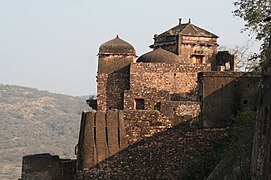Ranthambore Fort
This article needs additional citations for verification. (June 2013) |
| Ranthambore Fort | |
|---|---|
Fortress | |
| Location | Sawai Madhopur, Rajasthan, India |
| Coordinates | 26°1′13″N 76°27′18″E / 26.02028°N 76.45500°E |
| Area | 102 ha (0.39 sq mi) |
| Built | 10th Century CE |
| Type | Cultural |
| Criteria | Cultural: (ii)(iii) |
| Designated | 2013 (37th session) |
| Part of | Hill Forts of Rajasthan |
| Reference no. | 247 |
| ID | 247rev-003 |
| Region | Asia and the Pacific |
| Buffer Zone | 372 ha (1.44 sq mi) |
Ranthambore Fort lies within the
The Ranthambore Fort was built initially by yadava King Jayant in 5th century A.D. [1] In 2013, at the 37th session of the World Heritage Committee, Ranthambore Fort, along with 5 other forts of Rajasthan, was declared a UNESCO World Heritage Site under the group Hill Forts of Rajasthan.[2]
History
Under Yadavas
Archeological department of Jaipur circle the Ranthambore Fort was initially built by Yadava King Jayant in 5th century CE. The Yadavas ruled over it till they were expelled by Prithviraj Chauhan in the 12th century. Subsequently, the fort was later occupied by the Muslim rulers of Delhi. Hammiradeva was the most powerful ruler of Ranthambhore [1]
Under Chauhans Rajputs
Its earlier name was Ranastambhapura (Sanskrit: Raṇa-sthaṃba-pura, "City of the Battle Post").
After the defeat of
The Delhi Sultan
Under Mewar
The fortress was captured by various kings of Mewar. Ranthambore was under the direct rule of Rana Hamir Singh (1326–1364), Rana Kumbha (1433–1468) and Rana Sanga (1508–1528).[6][7][8]
Under Hadas

During Rana

Under Jaipur
The fortress passed to the
Temples
Inside Ranthambore fort, there are three
Nearby attractions
- Water gateways
- Kachida Valley
- Surwal Lake
- Sitla Mata
- Picnic sports
- Malik Talao
- Wild life
- Bakula
- Lakarda And Anantpura
- Rajbagh Talao
- Ranthambore National Park
- Historical places
- Jogi Mahal
- Padam Talao
- Raj Bagh Ruins
- Ranthambhore Fort
- Ranthambhore School Of Art
- Ganesha temple
- Jain Temple
Gallery
-
The way inside the fort
-
History of Ranthambore Fort written on the wall
-
Jain temple at Ranthambore Fort
-
Battees Khamba
-
Annapurna Temple
-
Fine rock art at Ranthambhore Fort
-
Old tomb, Ranthambore Fort
-
Rani Haveli
-
Ranthambore Fort Jain Temple
-
Entrance
-
Naulakha Gate, Ranthambhore Fort
See also
- Hill Forts of Rajasthan
- Chamatkarji
- Sawai Madhopur District
- Sawai Madhopur
- Rajiv Gandhi Regional Museum of Natural History
- Shilpgram, Sawai Madhopur
- Sawai Madhopur railway station
References
- ^ a b c Anil K., Tiwari (12 December 2023). "Ranthamhor Fort | Archaeological Survey of India Jaipur Circle". Archeological Survey of India. Retrieved 6 April 2024.
- ^ "UNESCO World Heritage". Archived from the original on 28 February 2018. Retrieved 27 February 2018.
- ISBN 978-3-11-065959-7.
- ]
- ISBN 9780842606189. Archivedfrom the original on 3 July 2023. Retrieved 6 October 2016.
- ISBN 978-0-8108-6401-6. Archivedfrom the original on 14 August 2023. Retrieved 14 March 2023.
- ^ IA, Vol. XLII, pp. 57-64
- ^ Mishra, Shyam Manohar (1977). Yasovarman of Kanau, p.123. Archived from the original on 29 May 2022. Retrieved 25 September 2012.
External links
 Ranthambore Fort travel guide from Wikivoyage
Ranthambore Fort travel guide from Wikivoyage














